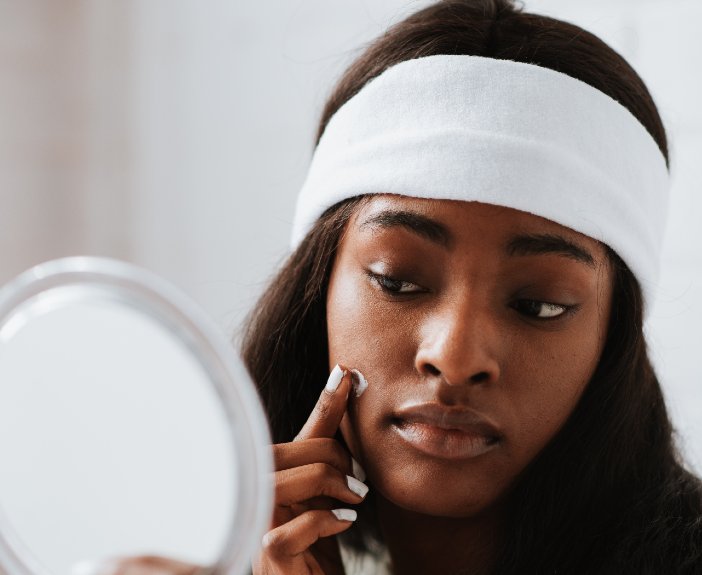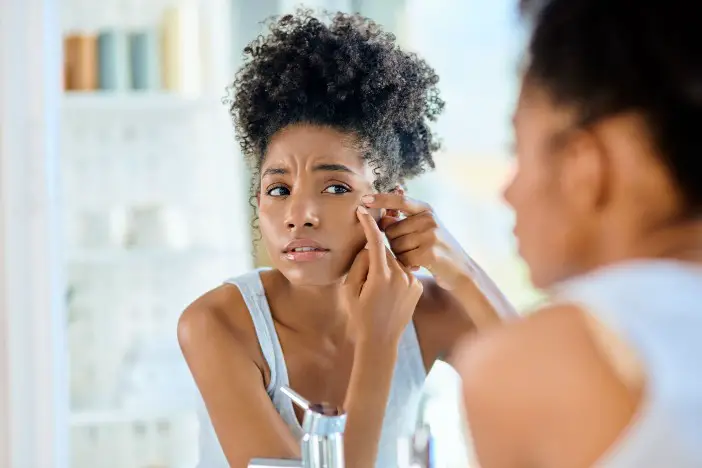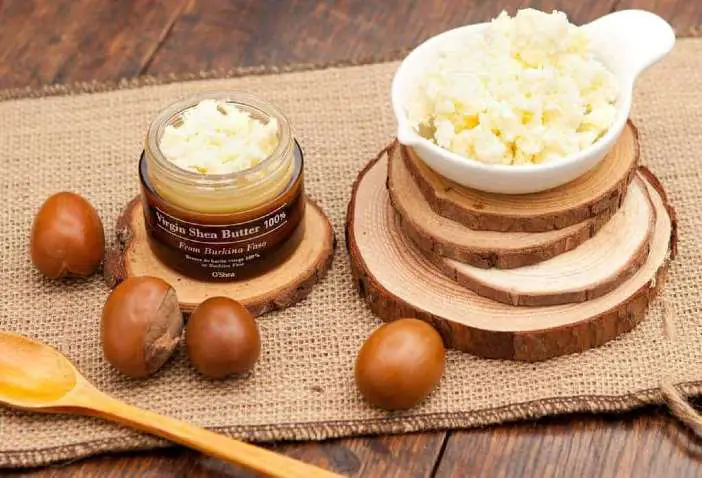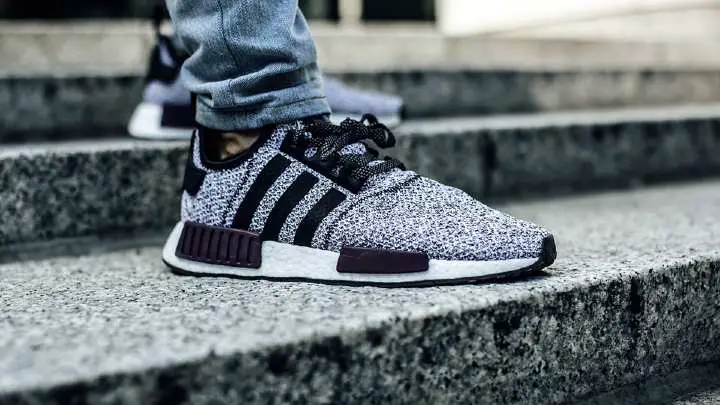When it comes to treating the skin with oils-natural or essential, I count people with dry skin the most fortunate. They can comfortably bask in everything the oils have to offer. But, if you have oily or acne-prone skin, you certainly will have concerns and questions like is shea butter comedogenic?
Will shea butter clog my pores? Can it be the reason why I have recurring skin breakouts?
Shea butter is a plant-based fat that is gotten from shea tree nuts which are mostly found in West Africa. Also, shea butter is widely suitable for all skin types because of its unrivaled anti-inflammatory and healing properties.
However, when it comes to skincare and cosmetic purposes, there have been concerns. There are questions on whether everyone and anyone can always use shea butter as a natural moisturizer and hydrator that it is. Are we all safe with shea butter?
Is Shea Butter Comedogenic?

Shea butter is comedogenic, especially to people with oily and breakout-prone skin.
The American Academy of Dermatology supports the claim that shea butter is comedogenic, given its consistency.
The skin is the largest body organ, and it is quite uncommon to see a person who is not concerned about their skin. A major area of concern is what to apply and what not to apply to our skin.
Meanwhile, shea butter’s comedogenicity is not without dispute. There isn’t so much from science to define comedogenic and non-comedogenic oils. So, it is dealt with from a standpoint of composition, texture, and skin type.
Composition of Shea butter
A board-certified dermatologist, Dr. Jennifer Herrmann, MD, says “plant-based oils contain essential fatty acids, vitamins, and antioxidants, which nourish the skin but also strengthen its barrier, increase elasticity, and fight damage from environmental chemicals and UV”.
Dr. Herrmann further said that some of these natural oils can be harmful to acne-prone skin. The fatty acids contained in shea butter include:
Oleic acid
This monosaturated fatty acid is naturally present in our bodies, in the skin’s natural oil called sebum. Sebum is the oil substance that covers the epidermis and is part of the natural barrier that aids moisture retention.
Oleic acid makes up about 55-60% of shea butter. Since it is already present in the skin, an extra addition will alter the natural skin barrier function. Consequently, leading to clogged pores. This makes it the major ingredient that makes shea butter comedogenic.
Stearic acid
Stearic acid is a non-essential fatty acid, this means that our bodies naturally produce stearic acid. It makes up to 20-50% of shea butter’s composition. Also, it is a major ingredient of body creams and lotions that give a satiny finish.
Over time, stearic acid is converted to oleic acid in the skin. And, this is the reason for clogged pores.
SEE: Experts Say This Is the Best Skincare Routine for Acne
Palmitic acid
Just like stearic acid, palmitic acid is also non-essential. Under certain circumstances, it can be converted to oleic acid. It has an 8% composition in shea butter.
Linoleic acid
Unlike all other acids present in shea butter, linoleic acid is an essential omega-6 polyunsaturated fatty acid. It is a vital moisturizer that the skin needs. However, it tends to be present in low concentrations (about 7%) as a result of excessive dryness or oil production.
Linoleic acid has great anti-inflammatory properties that are sometimes altered by palmitic acid. The resulting low concentrations affect the skin’s natural barrier functions. As a result, pores become clogged.
SEE: Is Cocoa Butter Good For Sunburn?
Shea Butter and Acne-Prone Skin

On the comedogenicity scale, shea butter ranks zero. This means that it is not likely to clog your pores. But, there is still no scientific proof to verify this claim.
Talking about the texture, shea butter is butter. This sums up to say, when you apply it to your skin, you layer your skin with a coating that becomes a barrier of oil. Although it is a natural moisturizer and hydrator, it can be too much for acne-prone skin.
While it loads your skin with certain benefits, it leads to excessive oiliness which is not good for oily and acne-prone skin. The naturally present oleic acids and the concentrations present in shea butter is the culprit of clogged pores.
“The moisturizers present in shea butter are some of the same moisturizers that the sebaceous glands produce”, explains Jody Levine, MD.
Furthermore, linoleic acid which can tame breakouts because of its higher anti-inflammatory properties in present in very low concentrations. These concentrations as against that of oleic acid are not so good for acne-prone skin. Joshua Zeichner, MD, says although it is rich in nutrients, it can cause skin breakouts.
Not to sound counterintuitive, but you can still treat your skin to shea butter. Skin experts say it is how you use it that matters. Also, it determines your susceptibility to acne breakouts. Rather than using raw shea butter, you can use beauty care products that contain shea butter.
This way, shea butter is mixed with other substances and may not be comedogenic. You can try products that contain high concentrations of linoleic acid. They include moisturizers like glycerin and non-comedogenic oils like jojoba oil.
SEE: This Is the Right Skincare Routine Specially Designed for Oily Skin
Benefits of Shea Butter

Although shea butter may be comedogenic for you, you do not have to give up on or stay away from it. Whether you have dry acne skin, oily or acne-prone skin, or sensitive skin; shea butter has something to give you. This plant-based oil offers your skin a lot of nourishing benefits.
They include:
1. Skin hydration
Shea butter is a good skin hydrator for every skin type. People with dry skin will find it soothing while those with sensitive skin types will find it calming. It sets the skin such that it can repel the effects of extreme and adverse temperatures and weather conditions.
2. Skin moisturizer
Although the fatty acids present in shea butter are what make it comedogenic, they are beneficial. These acids seep into the skin and moisturize it from the inside out. They replenish the body’s natural lipids and keep off skin dryness.
3. Shea butter reduces wrinkles
Wrinkles and fine lines make the skin age quickly. Massaging your skin with shea butter stimulates collagen production and smoothens the fine lines. It plumps your skin from the inside out. As a result, your skin feels soft, smooth, and looks youthful again.
4. Healing balm
Shea butter was traditionally used as a healing balm. In the modern world, it is still used for such purposes. Although shea butter is considered comedogenic, it still heals and fades away acne scars and skin blemishes. It contains vitamin E, an antioxidant that fosters skin healing.
Moreover, other skin issues like cracked heels, chapped lips, stretch marks, and peeling on other body parts are healed with shea butter massage. In addition, allergies like poison and insect bites can be eased by massing the affected skin area with shea butter.
SEE: Best Lavender Essential Oil to Boost Your Skin Health
5. Anti-inflammatory properties
Vitamins E & F are known for their anti-inflammatory properties. They are key ingredients of shea butter. When you apply shea butter to your skin, especially around acne scars, these vitamins work to reduce the inflammation around these scars.
Also, they reduce their appearances and consequently heal them. Another benefit of these vitamins is the glow they add to your skin. Shea butter calms the redness and frequent irritations that come with sensitive skin.
6. Shea butter evens skin tone
People with skin issues like hyperpigmentation or any other skin discoloration concern will find shea butter very useful. Regular application will even out your skin tone. This benefit does not fall too far from the scar healing benefit.
A good percentage of skin discoloration cases are a result of acne. Shea butter moisturizes the skin and lightens the acne scars.
7. Sunscreen
Creams, lotions, and any other beauty care product that contains shea butter are naturally embedded with sunscreen. Shea butter has a natural SPF of about 3-4 and this can be good for a claim that it is not comedogenic.
8. Haircare benefit
Shea butter is a universal beauty ingredient. Asides from your skin, your hair can also enjoy its richness and hydrating benefits. You will find out that most hair care products for the curly hair type make use of shea butter.
It moisturizes and hydrates your hair keeping frizz and breakage away. Additionally, it fights off dandruff and flaking scalp. However, you should use it with essential oils or other ingredients. These ingredients help to dissolve and carry its thick texture around better.
SEE: Best Acne Treatment
Frequently Asked Questions

Is shea butter comedogenic for my oily skin?
Yes, it is. Oily skin does not need skin care products that add more oil to the skin. Shea butter contains fatty acids that make it comedogenic.
If you have oily skin, you should not use shea butter alone on your skin. Use skin care products that contain shea butter. They will give you a different result from using raw shea butter-based products.
Why does shea butter cause my skin to break out?
Shea butter is comedogenic and can cause oily and acne-prone skin to breakout. It contains fatty acids like oleic and stearic acids which are naturally produced by the sebaceous gland.
The high concentrations of these acids coupled with the natural acids in the skin result in excessive oil production. Consequently, the pores become clogged and result in acne breakouts.
How should I use shea butter for my skin?
If you are looking to treat skin issues like cracked heels, chapped lips, or stretch marks, you can massage shea butter over the affected area. On the other hand, if you are using shea butter as a moisturizer, get skincare products that contain other ingredients like glycerin and essential oils.
Make a routine of applying a cream that contains shea butter in the morning and the evening. Also, you can make a facial mask out of shea butter and other ingredients for a weekly skincare routine.
Bottomline
Is shea butter comedogenic? Yes, it is if you have oily or acne-prone skin. Shea butter benefits every skin type. In addition, it is a great skin hydrator and moisturizer, keeping dryness and scaly skin at bay. The nutrients nourish your skin and help to maintain a natural glow.
There is no scientific backing to declare shea butter as a comedogenic oil. However, consider your skin type, shea butter’s texture, and fatty acid composition before you conclude. To get the best of using shea butter, complement it with a product that contains high concentrations of linoleic acid.
Ultimately, if you have great concerns as to whether you should use shea butter for your skin, consult a dermatologist. They will ask you questions about your concerns and skin issues history. Eventually, there will be a profitable deduction for you.
Thanks for reading.
Africana Fashion provides you with relevant skincare articles that help you achieve clear, flawless skin.






